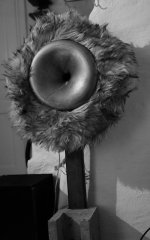Hi TNT!I have now lived and listen a lot to these the past days. I still very much enjoy them and I'm certainly glad I built them. But all isnt/wasnt completely dandy - is it ever 😉
Yes- there was harshness in the midrange. So the old CD / wg problem? I dont know. Its like a shsss bright guurlgle on choir and massed strings - impossible to live with.
Nice speakers! Great to see that they are working!
I don't want to be harsh (pun intended 😀 ), but that reminds me why I sold my ND1090 drivers (I know yours is NSD1095), after a while it was unbearable (for me) to listen music or voices with them, even at moderate or low SPL, EQ didn't helped.
Maybe you can figure it out what's the problem.
Thanks!
After my initial experiments I think it will be manageable. It seems that mechanical decoupling if WG is very important. I will also try wg dampening near the throat to see that that part is really rigid - high pressure there...
//
After my initial experiments I think it will be manageable. It seems that mechanical decoupling if WG is very important. I will also try wg dampening near the throat to see that that part is really rigid - high pressure there...
//
Hmm, indeed, 18Sound CDs have only a relative narrow sealing/dampening ring around the driver exit. Outside the diameter of that ring the CD and horn couples rigidly to each other. That's what you thought?
No not that junction but more how the whole WG/CD package is physically mounted to the rest of the speaker. I think it should be floating really. But I have looked at that one too - thinking that I would like to do a thin gasket to fill that "void" that will be outside the built in seal, surrounding the 1" opening - yes. Also, the built in seal seem very thin/porous... There is lot of energy exchange at the meeting of the WG and CD and my WG is quite thin and ringy (pling) at the start of the throat so I would like to put some more mass there to make it more sturdy/dampened.
//
//
I have done a few things after listening a lot and thinking some. One thought that struck me was; what if the CD+WG works as an exciter on a bending wave plate - that would be really nasty with the energy being excited before the acoustical throat/horn contribution - like a pre-echo. But it will be a really poor one with a really nasty bell resonance due to the shape of the "bender".
The bending action was adressed by decoupling the CD from the horn by a gasket for less mechanical energy transfer. As a general resonance precaution I engulfed the throat with Plastolina.
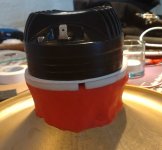
Also looking at the WG itself led to church towers and the powerful PA entity of the bell. I really don't want to listen to a bell so I had natural latex damp the backside of the WG.
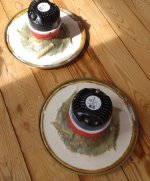
These 3 actions I have not measured on yet but I experience a useful improvement in SQ wrt. the sometime little harness that pop up and bite you. After this I could also without problem go from 1,6k to 1,3k XO.
I will measure this state and then continue with the following pretty brutal mods, hopefully returning further improvements:
- Do the same edge treatment as on the Göbeln benders - I will saw 45 degres, maybe 2 cm cuts with a thin blade around the edge of the backroll and fill these with Sikaflex. This is to kill the reflection going form the mouth rollover edge back to the throat.
- I will make an other long cut with same thin blade all the way form the mouth to the throat to kill any energy travelling in a circular manner - this I believe is one of the primary effects of the bell shape. Cuts will be filled with Sikaflex.
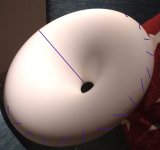
As is currently, it sound really good and I have no problem listening for hours - but I feel there is yet some to be wrenched out of this combo. The way to achieve that is to see to that the WG is just that, a WG and not a bending wave transducer. Here I feel there could be a little tiny graal hidden... perhaps...
//
The bending action was adressed by decoupling the CD from the horn by a gasket for less mechanical energy transfer. As a general resonance precaution I engulfed the throat with Plastolina.

Also looking at the WG itself led to church towers and the powerful PA entity of the bell. I really don't want to listen to a bell so I had natural latex damp the backside of the WG.

These 3 actions I have not measured on yet but I experience a useful improvement in SQ wrt. the sometime little harness that pop up and bite you. After this I could also without problem go from 1,6k to 1,3k XO.
I will measure this state and then continue with the following pretty brutal mods, hopefully returning further improvements:
- Do the same edge treatment as on the Göbeln benders - I will saw 45 degres, maybe 2 cm cuts with a thin blade around the edge of the backroll and fill these with Sikaflex. This is to kill the reflection going form the mouth rollover edge back to the throat.
- I will make an other long cut with same thin blade all the way form the mouth to the throat to kill any energy travelling in a circular manner - this I believe is one of the primary effects of the bell shape. Cuts will be filled with Sikaflex.

As is currently, it sound really good and I have no problem listening for hours - but I feel there is yet some to be wrenched out of this combo. The way to achieve that is to see to that the WG is just that, a WG and not a bending wave transducer. Here I feel there could be a little tiny graal hidden... perhaps...
//
Last edited:
Interresting. I have a large waveguide printed (from PLA)in pieces and I thought the construction glue in the not so perfect interfaces of the parts would prevent resonances (single parts were very dead on a knock test). But it clearly does not, the mouth rings at a knock test when held by the throat. When laid on a surface (it is rectangular), it does rinq way less, almost dead. Would latex help with that? How thick layer did you use?
The latex varied from filling almost the whole backroll to maybe a couple of mm on the sloping sides. Its hard and tedious to get that to stick... it hardens so slow and you need to paint repeatedly for an hour to get somewhere.
Yes, the bell resonance seem to be the most powerful one in existence - hence the use... 🙂 it needs be interrupted - a gap of say 1-2 mm filled with something soft, I have high hopes for.
I'm not sure latex would help in that situation - so much energy in play... maybe it need a solid foundation - like the table situation to really kill it. But it can't hurt.
//
Yes, the bell resonance seem to be the most powerful one in existence - hence the use... 🙂 it needs be interrupted - a gap of say 1-2 mm filled with something soft, I have high hopes for.
I'm not sure latex would help in that situation - so much energy in play... maybe it need a solid foundation - like the table situation to really kill it. But it can't hurt.
//
Last edited:
I have now made more injury to the WGs. I did saw a long path towards the centre but could not reach all the way. Was to lazy to remove the red stuff. Did tape the CD exit to prevent saw dust into the driver. Also, I did incisions at the rollback edge - say 10 of them 3cm long. All these cuts where filled with transparent silicone. The difference it made kan be heard in the knock test. Both the treated (but no silicone!) and the untreated are sitting on the CD and facing upwards - knock is on rollbak part. Hear attachment.... its should be obvious which one is which 😉
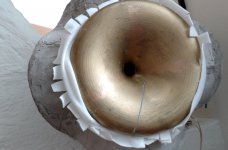
The above actions made the last hints of aggression go away. Again I could lower the Fo of the x-over a couple of 100 Hz. But also has made the sound leave the speakers to an even greater extent and sometimes I get spooked of some tones coming out of them - like a high pitched organ note in the beginning of https://tidal.com/browse/track/68961758 - this CD sounds extremely clean on the Hornflowers and is a joy to consume. As are many others. Bass from this recording is also very good. Surprisingly good coming form 4" drivers and a pretty small speaker.
As I play them now - in an odd room with slanting walls (roof top flat) and the distance between speakers are 2,5 m and distance to center speakers is 2,7m the soundstage is not very wide.
In general there is only one "flaw" with this speaker and it is its tendency to create a "loge" or opera box effect. Its like a delicate doll house with all the details and relations perfectly intact but it is still a doll house. It's small. This effect seem to come from the narrow directivity of the WG. It may be constant but it is rather narrow. So these speakers can not re-create the full size and depth experience of a 10th row center seat in a concert hall. Shade.
Recordings with dry and tight ambience integrate better as this is how my room sound. Recordings from big venues with a lot of acoustics is revealed immediately in two ways - the ambience is reproduce really fine with lot of details and dynamics - but it is like listen from an opera box - its limited in size and the border becomes really obvious as the acoustics in my room is so totally different.
I wish I can hear these in a bigger room with the speakers further apart. I have to som day - they are really special. Some fine tuning of filters and EQ still remain but I regard them as more or less finished.
On lesson learned is that the "funnel" (WG) may not make any sound by them selfs whatsoever. None. Nada. Silch. If you manage this, award is plenty. The WG needs to be softly connected to the CD so not to mechanically transfer any energy into the WG.
If I do another DC/WG based speaker I will model these cuts so that it will made by the print. I see a couple of wave patterns coming from the centre going to the edge as cuts, say 1-2 mm wide. Also at the mouth, no reflections must go back to the throat - slanted incisions should be made 2-4cm long - 15 of them is probably good. All these to be filled with silicone.
Back (bass) covers remain for a more proper look. Pictures to come. And some measurements of the final state - I did miss doing them before the last mods as promised... sorry.
//

The above actions made the last hints of aggression go away. Again I could lower the Fo of the x-over a couple of 100 Hz. But also has made the sound leave the speakers to an even greater extent and sometimes I get spooked of some tones coming out of them - like a high pitched organ note in the beginning of https://tidal.com/browse/track/68961758 - this CD sounds extremely clean on the Hornflowers and is a joy to consume. As are many others. Bass from this recording is also very good. Surprisingly good coming form 4" drivers and a pretty small speaker.
As I play them now - in an odd room with slanting walls (roof top flat) and the distance between speakers are 2,5 m and distance to center speakers is 2,7m the soundstage is not very wide.
In general there is only one "flaw" with this speaker and it is its tendency to create a "loge" or opera box effect. Its like a delicate doll house with all the details and relations perfectly intact but it is still a doll house. It's small. This effect seem to come from the narrow directivity of the WG. It may be constant but it is rather narrow. So these speakers can not re-create the full size and depth experience of a 10th row center seat in a concert hall. Shade.
Recordings with dry and tight ambience integrate better as this is how my room sound. Recordings from big venues with a lot of acoustics is revealed immediately in two ways - the ambience is reproduce really fine with lot of details and dynamics - but it is like listen from an opera box - its limited in size and the border becomes really obvious as the acoustics in my room is so totally different.
I wish I can hear these in a bigger room with the speakers further apart. I have to som day - they are really special. Some fine tuning of filters and EQ still remain but I regard them as more or less finished.
On lesson learned is that the "funnel" (WG) may not make any sound by them selfs whatsoever. None. Nada. Silch. If you manage this, award is plenty. The WG needs to be softly connected to the CD so not to mechanically transfer any energy into the WG.
If I do another DC/WG based speaker I will model these cuts so that it will made by the print. I see a couple of wave patterns coming from the centre going to the edge as cuts, say 1-2 mm wide. Also at the mouth, no reflections must go back to the throat - slanted incisions should be made 2-4cm long - 15 of them is probably good. All these to be filled with silicone.
Back (bass) covers remain for a more proper look. Pictures to come. And some measurements of the final state - I did miss doing them before the last mods as promised... sorry.
//
Attachments
After a long trail period wanting to use the Topping L30 HP as an amp for the high frequency part I have come to the conclusion that it sounds a bit strained - even at low levels, compared to a dedicated power amp. So no luck there. It's still great with HP but maybe there is another level there too.
I'm now playing the HF section driven by an Anaview str-ams0100-2300 and its is considerable improvement. Maybe the HP amp was a bad idea from the beginning... on paper it looked like it should work.
//
I'm now playing the HF section driven by an Anaview str-ams0100-2300 and its is considerable improvement. Maybe the HP amp was a bad idea from the beginning... on paper it looked like it should work.
//
An other observation is that trying to run this CD from 1300Hz is to low. It simply don't sound right despite the level and waterfall measurements show why. I'm now at 1700 and that seem to go OK. More EQ and filter tweaking to be made for sure...
//
//
It could be a tad hot in a specific range due to inter-aural cross talk? With waveguides comes less room interference making things like that a tad more obvious.
Listen to one speaker playing mono to see if it still bothers you. If that sounds clean, it is the Stereo sum that is causing the grief.
A small dip centered at ~3700 Hz might help in that case, and a smaller at ~7200 Hz if the previous dip worked. If you're listening in a ~3m stereo triangle.
Listen to one speaker playing mono to see if it still bothers you. If that sounds clean, it is the Stereo sum that is causing the grief.
A small dip centered at ~3700 Hz might help in that case, and a smaller at ~7200 Hz if the previous dip worked. If you're listening in a ~3m stereo triangle.
Now I'm here in my sofa and it just get better and better... 1dB/oct. A tad more and a bit of "sanding" 🙂

//
//
Inspired by the diffraction and backroll discussion in the ATH thread, I'll give You "Horncoyote"... or, when Chewbecca moved in ... 🙂
Either I'm crazy or this is the most important tweak I have done to the speakers. Transformation is the only word I can think of.
They became so much calmer and fuller - its spokey - is diffraction such an evil force... really.... had a hunch but I'm surprised by this.
Looks just got even more interesting I think... haute couture.... a furry mat for 25€.

//
Either I'm crazy or this is the most important tweak I have done to the speakers. Transformation is the only word I can think of.
They became so much calmer and fuller - its spokey - is diffraction such an evil force... really.... had a hunch but I'm surprised by this.
Looks just got even more interesting I think... haute couture.... a furry mat for 25€.
//
Attachments
Its like The Trouble with Tribbles mated with your speaker. I applaud you for ingenuity.
Yeah, looks great! 😀 there is more things changing than just edge diffraction so audible difference is probably combination of multiple things. For example output of the woofers is affected as well. Anyway, if the sound got better then why not, leave them on for the winter🙂 Are you planning to measure it?
- Home
- Loudspeakers
- Multi-Way
- Hornflower 2-way point source
